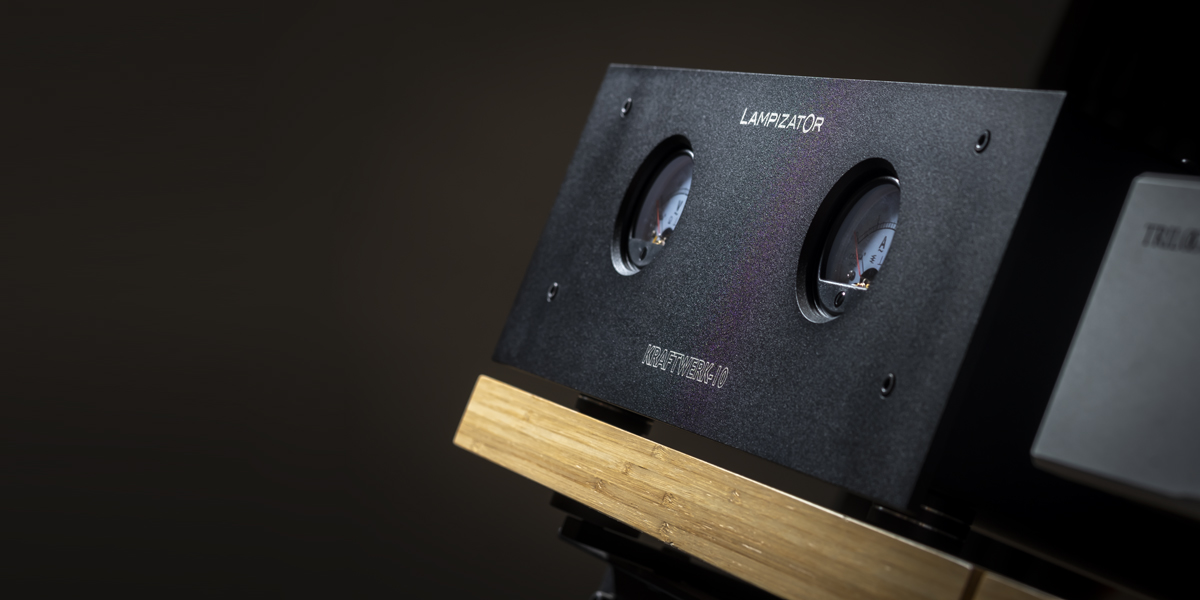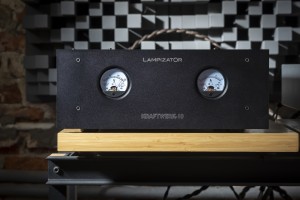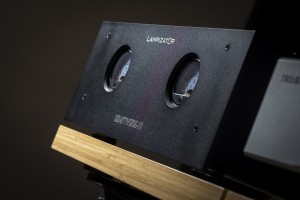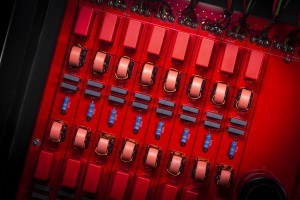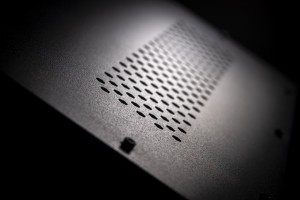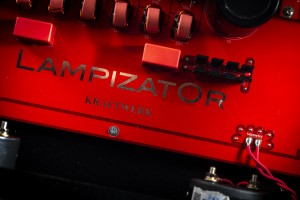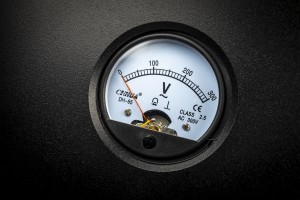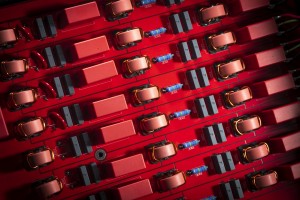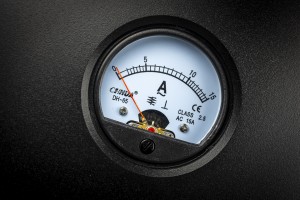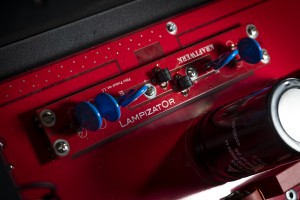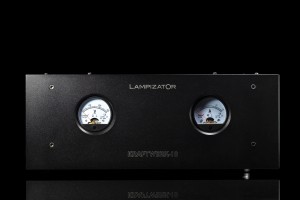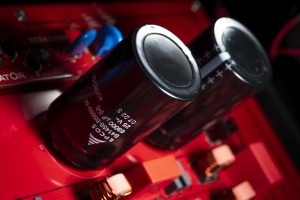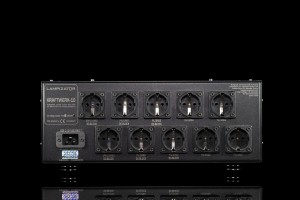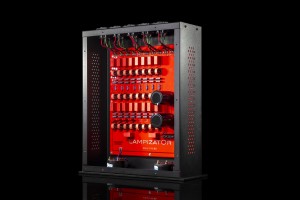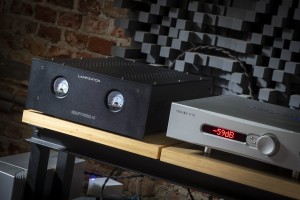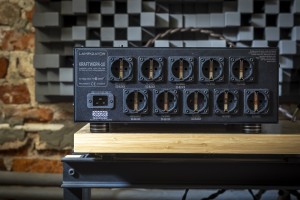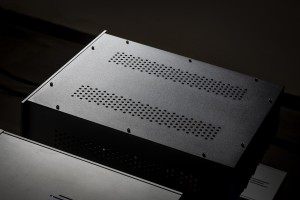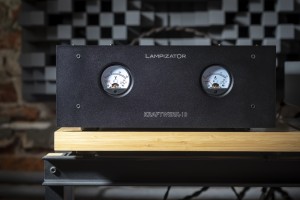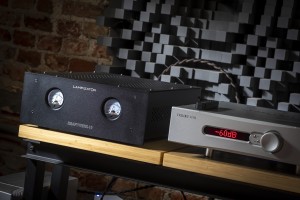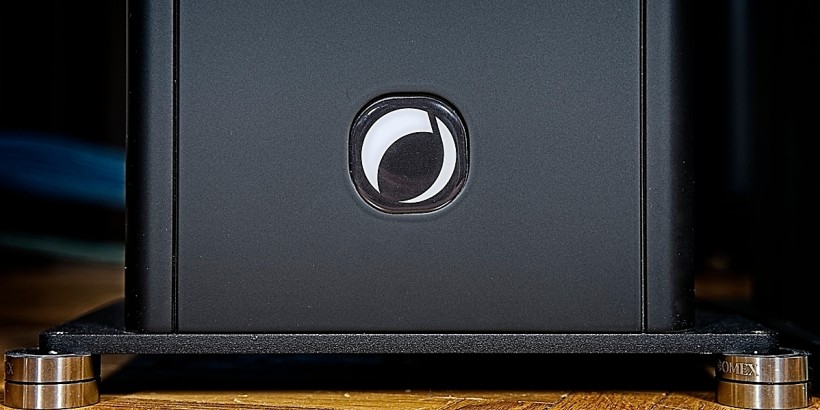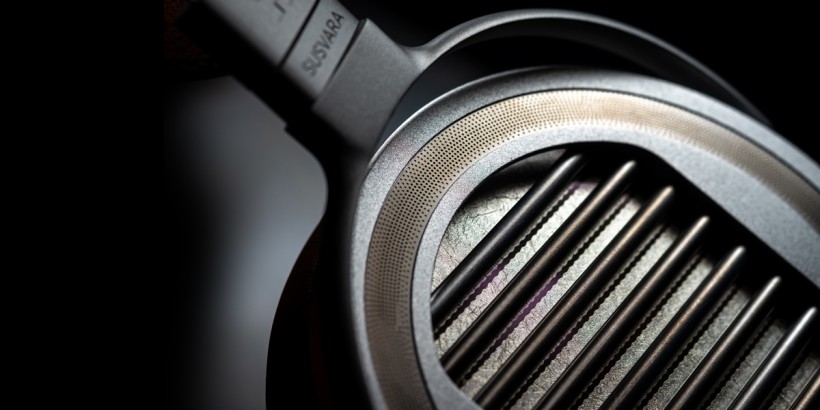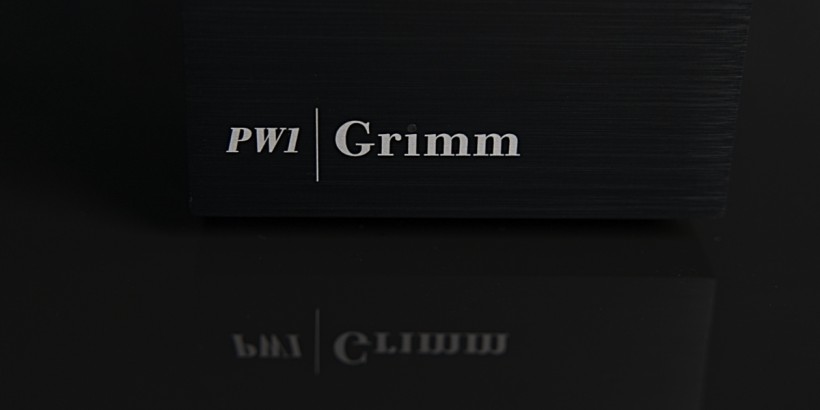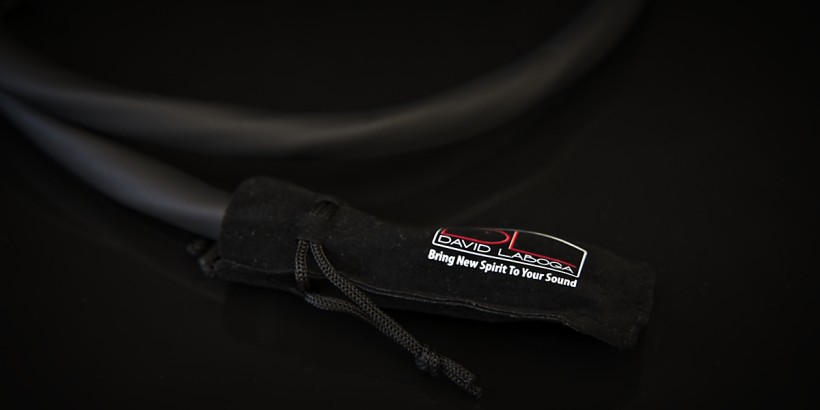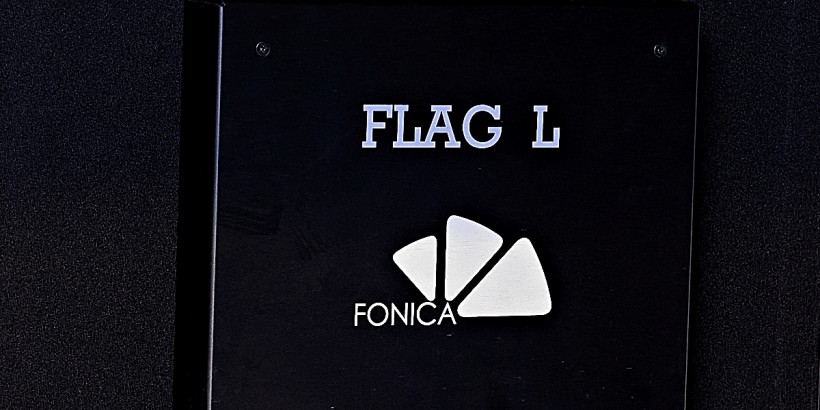While the LampizatOr roster comprises mainly DACs, it also lists several other devices including Kraftwerk-10 power distributor. That’s our subject this time around. Enjoy!
Power plant
I’m not sure whether this is common knowledge or not, but many performance-driven audio enthusiasts follow the protocol that encourages mix ‘n’ matching hardware from manufacturers with clearly defined specializations. No wonder, spending money on a company’s strongest asset class is a common-sense decision on many levels. To make it easier for consumers, most audio houses precisely define what that is. In this context, financing an amp or DAC made by a speaker or cable company initially may seem risky business. My experience tells me something else. A well-respected audio business that branches out beyond its core offer still has a reputation to uphold, so results must follow no matter what it does. Otherwise consumer ears will quickly brand the outcome as nothing more than a mere portfolio extender. No serious audio biz with lots of street cred wants that. My audio system is largely the result of chasing specialist gear. LampizatOr DAC, Boenicke and sound|kaos speakers, Innuos server/streamer and Trilogy analog end communicate that more than well. Then again, Boenicke cables and speaker filter, LessLoss outlet multiplier and Nic Poulson’s linear PSU are my ace reminders to always stay curious and look beyond the main lineup of those manufacturers I deem as highly successful. Stuff outside their main turf often packs major surprises. While LampizatOr is a DAC house first and foremost, it fits that profile too. The recently reviewed Horizon360 is my fourth D/A machine designed by Łukasz Fikus and his team. One look at their site however is all it takes to notice that their scope goes way beyond just the digital domain. It is accurate to say that one could assemble a nearly complete audio system using only building blocks with the LampizatOr logo on them.
My audio system is largely the result of chasing specialist gear. LampizatOr DAC, Boenicke and sound|kaos speakers, Innuos server/streamer and Trilogy analog end communicate that more than well. Then again, Boenicke cables and speaker filter, LessLoss outlet multiplier and Nic Poulson’s linear PSU are my ace reminders to always stay curious and look beyond the main lineup of those manufacturers I deem as highly successful. Stuff outside their main turf often packs major surprises. While LampizatOr is a DAC house first and foremost, it fits that profile too. The recently reviewed Horizon360 is my fourth D/A machine designed by Łukasz Fikus and his team. One look at their site however is all it takes to notice that their scope goes way beyond just the digital domain. It is accurate to say that one could assemble a nearly complete audio system using only building blocks with the LampizatOr logo on them.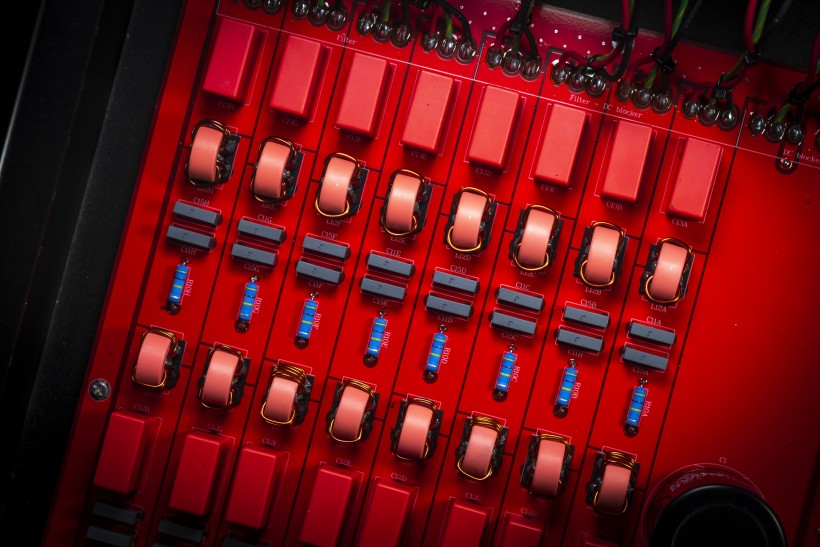 The current LampizatOr lineup features eleven DACs atop a line stage, two phono preamps, a server/streamer device, four amps and many cables to make all this lot operational. As far as the subject of power goes, for about two decades Łukasz was very happy about his now discontinued Silk conditioner that originated as the extension of the man’s diploma project he developed during his student times. While LampizatOr’s well-established digital profile suggests that this is the CEO’s specialty, it is not. He’s always been as much into power as he is into everything that involves tubes, so inherently analog matters to begin with. Glowing bits are his way of forcing digital hardware to sound just the way he likes. More importantly, Silk was a thing long before the LampizatOr brand came to be. This tells us that ever since his early days as an audio engineer, Łukasz took the subject of power seriously. Not many people are aware of this simply because, as popular as they are, LampizatOr DACs outshine the company’s other efforts by a substantial margin. I can’t fault Łukasz for playing it smart and mainly advertising goods he’s the most known for. The more I know him however, the more curious I become about his other products. Maybe among these less popular designs hides a gem that just awaits to be discovered? One can’t know without fishing in that pond, so let’s.
The current LampizatOr lineup features eleven DACs atop a line stage, two phono preamps, a server/streamer device, four amps and many cables to make all this lot operational. As far as the subject of power goes, for about two decades Łukasz was very happy about his now discontinued Silk conditioner that originated as the extension of the man’s diploma project he developed during his student times. While LampizatOr’s well-established digital profile suggests that this is the CEO’s specialty, it is not. He’s always been as much into power as he is into everything that involves tubes, so inherently analog matters to begin with. Glowing bits are his way of forcing digital hardware to sound just the way he likes. More importantly, Silk was a thing long before the LampizatOr brand came to be. This tells us that ever since his early days as an audio engineer, Łukasz took the subject of power seriously. Not many people are aware of this simply because, as popular as they are, LampizatOr DACs outshine the company’s other efforts by a substantial margin. I can’t fault Łukasz for playing it smart and mainly advertising goods he’s the most known for. The more I know him however, the more curious I become about his other products. Maybe among these less popular designs hides a gem that just awaits to be discovered? One can’t know without fishing in that pond, so let’s.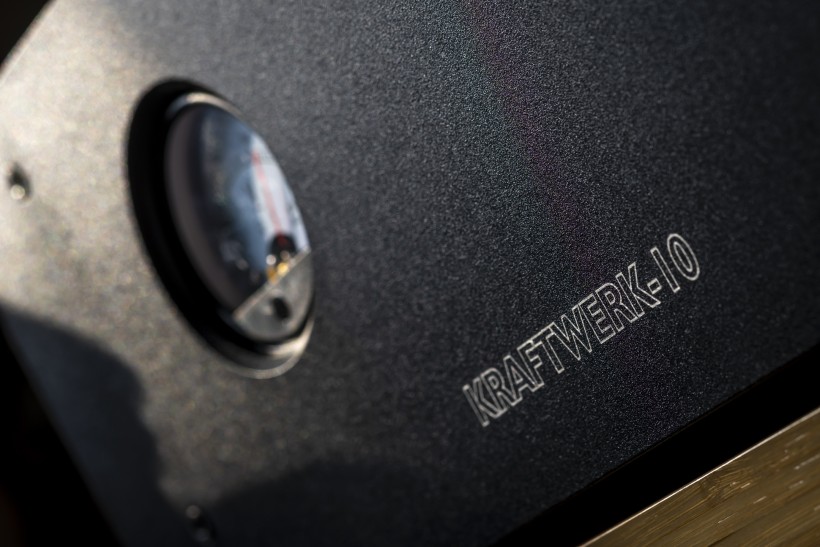 Although I knew of Silk’s existence ever since I met its creator, I never got the chance to take this power box for a spin and see what it does for me. Now that’s off the table. A while ago the company’s entire roster underwent some major visual changes. The new styling made many old designs not fit for keeping them alive. Unsurprisingly, the oldtimer Silk didn’t make the cut. Good stuff if someone asks me and many other LampizatOr fans who’d also agree that the manufacturer’s new enclosures look and feel far fancier. As for the Silk platform itself, about a year ago it was replaced by a more elaborate and modern effort named Karftwerk-10. Łukasz asked whether I’d like to try it out. As a sucker for all things related to power, I was in.
Although I knew of Silk’s existence ever since I met its creator, I never got the chance to take this power box for a spin and see what it does for me. Now that’s off the table. A while ago the company’s entire roster underwent some major visual changes. The new styling made many old designs not fit for keeping them alive. Unsurprisingly, the oldtimer Silk didn’t make the cut. Good stuff if someone asks me and many other LampizatOr fans who’d also agree that the manufacturer’s new enclosures look and feel far fancier. As for the Silk platform itself, about a year ago it was replaced by a more elaborate and modern effort named Karftwerk-10. Łukasz asked whether I’d like to try it out. As a sucker for all things related to power, I was in. From the on-site Kraftwerk description we learn that the AC and RFI/EMI influence on electronics was the company founder’s study subject. The original Silk design was his take on an efficient AC box that went about its business without separation transformers, AC regeneration circuits and deep filtering. Łukasz saw these means as culprits largely responsible for sucking out vividness and involvement from music. The first Silk was built to filter out the mains noise without truncating dynamics particularly of current-hungry amps. Most manufacturers versed in topologically alike devices would approve this approach. They know that stripping noise from AC power is achievable in many different ways and quite simple, on the contrary to executing this plan without limiting or obstructing current flow. This is precisely why the most effective power boxes I’m aware of say nay to coils, caps, protective measures (fuses, breakers, MOVs) and pretty much anything else that isn’t their makers’ in-house developed non-resistive passive filtering components. That’s the common ground for this utilitarian breed, purposely designed as purist wall outlet multipliers.
From the on-site Kraftwerk description we learn that the AC and RFI/EMI influence on electronics was the company founder’s study subject. The original Silk design was his take on an efficient AC box that went about its business without separation transformers, AC regeneration circuits and deep filtering. Łukasz saw these means as culprits largely responsible for sucking out vividness and involvement from music. The first Silk was built to filter out the mains noise without truncating dynamics particularly of current-hungry amps. Most manufacturers versed in topologically alike devices would approve this approach. They know that stripping noise from AC power is achievable in many different ways and quite simple, on the contrary to executing this plan without limiting or obstructing current flow. This is precisely why the most effective power boxes I’m aware of say nay to coils, caps, protective measures (fuses, breakers, MOVs) and pretty much anything else that isn’t their makers’ in-house developed non-resistive passive filtering components. That’s the common ground for this utilitarian breed, purposely designed as purist wall outlet multipliers. In their context, Kraftwerk-10 is a traditional conditioner design, built to remove high-frequency AC noise and DC offset, power up to 10 devices and provide surge/over-voltage/lightning protection for those connected to it. While this is a rather useful utility list, it’s fair to ask about the total cost we pay for it in sonics. More about that shortly. The key differences between Karftwerk-10 and Silk don’t involve the original circuit design. Łukasz explained that all the feedback he got from dozens of Silk customers was wholly positive, so he saw no need to change anything in this regard. If it ain’t broken, don’t fix it. The new distributor’s housing measures (W x D x H) 440 x 505 x 180mm and is the largest I’ve seen in such a product by far. It also shows 10/11kg on the scale with black/copper bonnet, so is enjoyably light. At my place the product ran cool even under load, so I’m guessing that the role of heavy perforations on cheeks and hood is to make the exterior nicer to look at. The front panel busy with analog voltage and amperage meters looks rather vintage, while the business end with a rarely seen C19 inlet allows Kraftwerk-10 to withstand up to 100A (!!!) peak current load, and each of its 10 inlets is rated up to 10A and 2,3kW. Four filtered sockets neighbor with the second filtered quad that’s additionally coupled with the DC blocker circuit, while the remaining two outlets that also enjoy it remain unfiltered. Needless to say, these options invite us to experiments with connecting our electronics into various outlets and trying what works best. There’s more to this. Many even far more expensive power distributors have one common output type, some feature two, usually for digital/analog and high-/low-current electronics. Three specialized outlet groups are rare and also one of Kraftwerk-10’s main attractors.
In their context, Kraftwerk-10 is a traditional conditioner design, built to remove high-frequency AC noise and DC offset, power up to 10 devices and provide surge/over-voltage/lightning protection for those connected to it. While this is a rather useful utility list, it’s fair to ask about the total cost we pay for it in sonics. More about that shortly. The key differences between Karftwerk-10 and Silk don’t involve the original circuit design. Łukasz explained that all the feedback he got from dozens of Silk customers was wholly positive, so he saw no need to change anything in this regard. If it ain’t broken, don’t fix it. The new distributor’s housing measures (W x D x H) 440 x 505 x 180mm and is the largest I’ve seen in such a product by far. It also shows 10/11kg on the scale with black/copper bonnet, so is enjoyably light. At my place the product ran cool even under load, so I’m guessing that the role of heavy perforations on cheeks and hood is to make the exterior nicer to look at. The front panel busy with analog voltage and amperage meters looks rather vintage, while the business end with a rarely seen C19 inlet allows Kraftwerk-10 to withstand up to 100A (!!!) peak current load, and each of its 10 inlets is rated up to 10A and 2,3kW. Four filtered sockets neighbor with the second filtered quad that’s additionally coupled with the DC blocker circuit, while the remaining two outlets that also enjoy it remain unfiltered. Needless to say, these options invite us to experiments with connecting our electronics into various outlets and trying what works best. There’s more to this. Many even far more expensive power distributors have one common output type, some feature two, usually for digital/analog and high-/low-current electronics. Three specialized outlet groups are rare and also one of Kraftwerk-10’s main attractors.
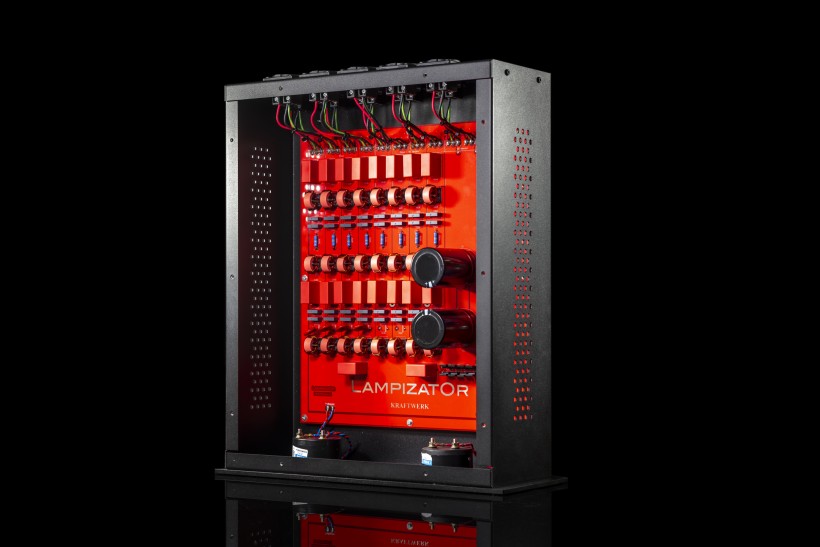 Today’s internals narrow down to one massive PCB packed with two large mains DC-blocking caps and eight separate filtering blocks in total. Each circuit comprises parts that form three independent filters, designed to engage at about 100kHz and overlap to provide continuous noise-trimming service far into the infra realm. The small protection module piggy-backed onto the Kraftwerk-10’s main laminate is based on varistors aka MOVs, so parts which purposely go bust upon encountering a voltage spike. When that happens, new units have to be installed in order to provide their usual service. To save time and make the entire procedure easier for their customers, team LampizatOr simply replaces entire modules. Lastly, Kraftwerk-10 dressed in all black sells for €4’000, which seems oddly affordable considering the manufacturer’s usual stickers. Now it’s time to see how it fares where it counts.
Today’s internals narrow down to one massive PCB packed with two large mains DC-blocking caps and eight separate filtering blocks in total. Each circuit comprises parts that form three independent filters, designed to engage at about 100kHz and overlap to provide continuous noise-trimming service far into the infra realm. The small protection module piggy-backed onto the Kraftwerk-10’s main laminate is based on varistors aka MOVs, so parts which purposely go bust upon encountering a voltage spike. When that happens, new units have to be installed in order to provide their usual service. To save time and make the entire procedure easier for their customers, team LampizatOr simply replaces entire modules. Lastly, Kraftwerk-10 dressed in all black sells for €4’000, which seems oddly affordable considering the manufacturer’s usual stickers. Now it’s time to see how it fares where it counts.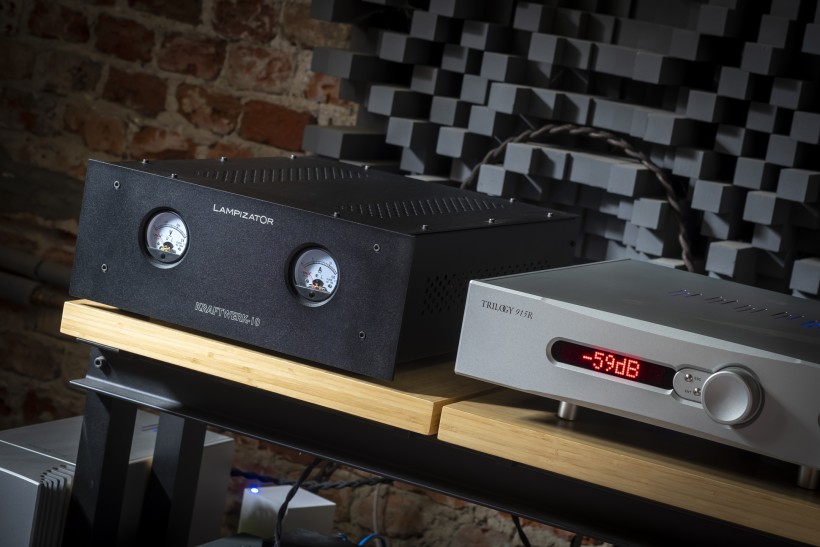 I like to think that I’m fairly lucky as far as product comparisons go, in the sense that usually I get to sample hardware that doesn’t require a lot to make the necessary swaps. This time around however Lady Luck turned her back on me. When power products such as Kraftwerk-10 are on the menu, downtime and multiple cable moves are a part of the routine. The local distributor connected to the duplex wall outlet’s one socket via the manufacturer’s C19-terminated power cord, while the other mains opening saw LessLoss Entropic C-MARC power cable that went into the same company’s Power Distributor. After each back and forth I had to turn off six devices in total (my streamer, DAC, linear PSU and analog end), reconnect as many C-MARC power cables either to the Polish or Lithuanian box, turn on all this electronic lot, wait for about two minutes and only then listen. Rinse and repeat as many times as required. Here I should mention that my full power chain is built upon the LessLoss box that goes into the Boenicke Power Gate for twice their filtering efficiency. Alas, using this posh stack against today’s effort wouldn’t be fair. Besides, mapping what the Kraftwerk-10 loaner could do against a similarly priced competitor was the goal. The first power cord that goes between the power distributor/ strip and wall is critical for the entire system’s performance, so ideally the same cable should feed both the LessLoss and LampizatOr to make their fight even. Not today, courtesy of the latter’s C19 inlet that didn’t accept C13 plugs on the C-MARC power cords at my disposal.
I like to think that I’m fairly lucky as far as product comparisons go, in the sense that usually I get to sample hardware that doesn’t require a lot to make the necessary swaps. This time around however Lady Luck turned her back on me. When power products such as Kraftwerk-10 are on the menu, downtime and multiple cable moves are a part of the routine. The local distributor connected to the duplex wall outlet’s one socket via the manufacturer’s C19-terminated power cord, while the other mains opening saw LessLoss Entropic C-MARC power cable that went into the same company’s Power Distributor. After each back and forth I had to turn off six devices in total (my streamer, DAC, linear PSU and analog end), reconnect as many C-MARC power cables either to the Polish or Lithuanian box, turn on all this electronic lot, wait for about two minutes and only then listen. Rinse and repeat as many times as required. Here I should mention that my full power chain is built upon the LessLoss box that goes into the Boenicke Power Gate for twice their filtering efficiency. Alas, using this posh stack against today’s effort wouldn’t be fair. Besides, mapping what the Kraftwerk-10 loaner could do against a similarly priced competitor was the goal. The first power cord that goes between the power distributor/ strip and wall is critical for the entire system’s performance, so ideally the same cable should feed both the LessLoss and LampizatOr to make their fight even. Not today, courtesy of the latter’s C19 inlet that didn’t accept C13 plugs on the C-MARC power cords at my disposal.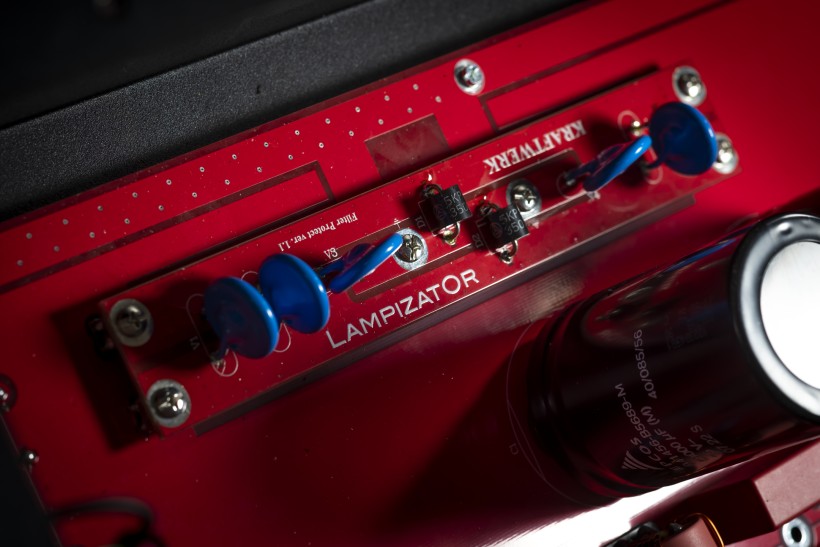 The last time a proper power conditioner had a full-time vacancy in my system was several years ago. Since then I simply learned what quite a few other reviewers have known for far longer. Our kind generally agrees that high-tiered purist passive outlet multipliers beat power conditioners on articulation, imaging specificity and particularly quickness and dynamics. The former designs score higher notes on these fronts largely because of what they don’t have inside, namely the usual current-obstructing filtering parts and also bits that protect our hardware from voltage spikes incoming from the mains. If we accept that this is the actual status quo, the trade off that follows is painfully obvious. Then it’s on us to decide whether the safety of our components is worth sacrificing sound quality or not. For two reasons I’m against it. One, I don’t see the need for the additional protection between my power line’s high-grade thermionic breaker and electronic kit that sports fused inlets anyway. Two, I want my system to always sound at its very best. If skipping one safety layer is the price to pay for achieving this, so be it. Your mileage may vary, however. If your electric installation has a track record of causing costly faults, then a conditioner box capable of preventing them isn’t a bad idea. Sound quality is also a matter of perspective. If your system is plenty quick, dynamic and outlined as is, but also piercing, hollow, anemic and color-wise pale, a touch more body, warmth and calmness baked into a typical power conditioner’s profile may offset these downsides.
The last time a proper power conditioner had a full-time vacancy in my system was several years ago. Since then I simply learned what quite a few other reviewers have known for far longer. Our kind generally agrees that high-tiered purist passive outlet multipliers beat power conditioners on articulation, imaging specificity and particularly quickness and dynamics. The former designs score higher notes on these fronts largely because of what they don’t have inside, namely the usual current-obstructing filtering parts and also bits that protect our hardware from voltage spikes incoming from the mains. If we accept that this is the actual status quo, the trade off that follows is painfully obvious. Then it’s on us to decide whether the safety of our components is worth sacrificing sound quality or not. For two reasons I’m against it. One, I don’t see the need for the additional protection between my power line’s high-grade thermionic breaker and electronic kit that sports fused inlets anyway. Two, I want my system to always sound at its very best. If skipping one safety layer is the price to pay for achieving this, so be it. Your mileage may vary, however. If your electric installation has a track record of causing costly faults, then a conditioner box capable of preventing them isn’t a bad idea. Sound quality is also a matter of perspective. If your system is plenty quick, dynamic and outlined as is, but also piercing, hollow, anemic and color-wise pale, a touch more body, warmth and calmness baked into a typical power conditioner’s profile may offset these downsides. The question to ask is whether Kraftwerk-10 behaves like a conventional distributor or not. While designs such as this one make dynamic lively sound in comparison to standard-issue juice bars, my experience tells me that purist single-task affairs i.e. by Ansuz or LessLoss have the clear advantage on that score. This is one of the key reasons why I’ve been using the Lithuanian product. For some extra context, in its own review I wrote that: “…it behaved in a predictable manner. Its gearing for extensive noise rejection translated into deep background blackness upon which instrumental moisture, resolution and sensation of the aural space itself blossomed. Listeners not particularly familiar with such action will find it a bit eerie at first, simply because i.e. speakers, DACs and amps voiced to sound thick, syrupy and round can’t be well-illuminated resolved spacious types on top of that. Although usually the balance slides between these two opposite trait groups, highly effective power components are subject to different laws that allow for blending them. Their darkish overall aesthetic as the result of potent noise trimming not only removes excess fuzz, bloom, grain and veil, but it also accelerates their sonic MO and makes them more open, vigorous and alive. In other words, products such as the LessLoss distributor know how to sound juicy, texturally generous, propulsive, informational and spatially unrestricted at the same time. That makes them as special and desirable as they are extremely universal.”
The question to ask is whether Kraftwerk-10 behaves like a conventional distributor or not. While designs such as this one make dynamic lively sound in comparison to standard-issue juice bars, my experience tells me that purist single-task affairs i.e. by Ansuz or LessLoss have the clear advantage on that score. This is one of the key reasons why I’ve been using the Lithuanian product. For some extra context, in its own review I wrote that: “…it behaved in a predictable manner. Its gearing for extensive noise rejection translated into deep background blackness upon which instrumental moisture, resolution and sensation of the aural space itself blossomed. Listeners not particularly familiar with such action will find it a bit eerie at first, simply because i.e. speakers, DACs and amps voiced to sound thick, syrupy and round can’t be well-illuminated resolved spacious types on top of that. Although usually the balance slides between these two opposite trait groups, highly effective power components are subject to different laws that allow for blending them. Their darkish overall aesthetic as the result of potent noise trimming not only removes excess fuzz, bloom, grain and veil, but it also accelerates their sonic MO and makes them more open, vigorous and alive. In other words, products such as the LessLoss distributor know how to sound juicy, texturally generous, propulsive, informational and spatially unrestricted at the same time. That makes them as special and desirable as they are extremely universal.” There’s also this follow up: “There’s no question that the LessLoss’ inherently fetching dark round bloomy anchored sound makes a nice first focal point to stop at and appreciate. Once that early sensation settles in however, the product introduces itself as a resolution fiend capable of casting enormously large landscapes busy with easily served details and pinpoint accurate finely outlined sound sources. The Lithuanian’s ability to behave this velvety, smooth, atmospheric, aurally gifted, elastic and keen on extracting tiniest dust particles is highly admirable in my book. Performance of this rare all-encompassing list comes as superbly balanced and free from any obvious trade-offs. As such the LessLoss won’t steer a setup’s general gestalt in any particular direction. Instead it’ll gladly and gracefully elevate what’s already there. Speaking metaphors, it won’t carry out plastic surgery on a system to radically turn its voice into something else. Rather, it’s an expert makeup artist with the skill set required to emphasize a system’s very best assets. Above all else however, the LessLoss renders music as substantially more flowing and digestible than before, which I see as its primary attractor and most critical task. This highly universal and accomplished product will audibly improve every setup I can imagine no matter its core flavor.”
There’s also this follow up: “There’s no question that the LessLoss’ inherently fetching dark round bloomy anchored sound makes a nice first focal point to stop at and appreciate. Once that early sensation settles in however, the product introduces itself as a resolution fiend capable of casting enormously large landscapes busy with easily served details and pinpoint accurate finely outlined sound sources. The Lithuanian’s ability to behave this velvety, smooth, atmospheric, aurally gifted, elastic and keen on extracting tiniest dust particles is highly admirable in my book. Performance of this rare all-encompassing list comes as superbly balanced and free from any obvious trade-offs. As such the LessLoss won’t steer a setup’s general gestalt in any particular direction. Instead it’ll gladly and gracefully elevate what’s already there. Speaking metaphors, it won’t carry out plastic surgery on a system to radically turn its voice into something else. Rather, it’s an expert makeup artist with the skill set required to emphasize a system’s very best assets. Above all else however, the LessLoss renders music as substantially more flowing and digestible than before, which I see as its primary attractor and most critical task. This highly universal and accomplished product will audibly improve every setup I can imagine no matter its core flavor.”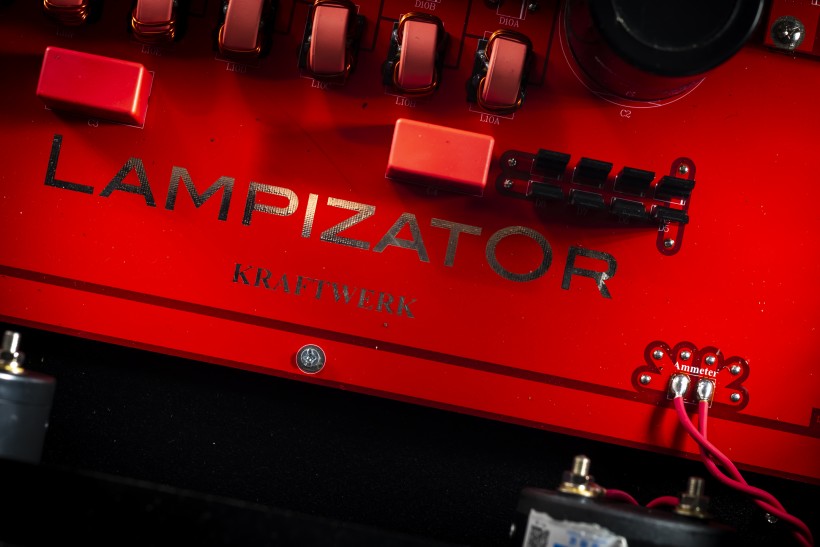 With that lay of the land, we can now move onto how the Kraftwerk-10 loaner fared against the LessLoss. Unsurprisingly, the two were quite similar on the mandatory stuff. As a product designed to strip noise incoming from the mains, the former injected the same unmistakable blackness into space that all sound sources and tiny dust particles call home. This one observation sufficed to appreciate the local’s filtering efficiency and was a nice forecast for things yet to come, but I didn’t expect anything less. This specific virtue is the primary upshot to expect even upon moving from a $5 power strip to a decent audio equivalent priced way below today’s model. My point here is that backdrop inkiness that easily registers isn’t difficult to execute. The challenging part is in securing that first base without stealing from shove, tone, resolution, openness and agility. There are however degrees to this sensual darkness. When applied generously, it allows other traits to shine. As truly ace in this regard as it is, the LessLoss makes my system’s sound very effortless, liquid, spatially grand and tonally intense. As such, this distributor represents a fully ripe apple that combines spot on sweetness with just a touch of citric flavor. In this fruity context, the Kraftwek-10 offered a more acidic harder bite that was still very sweet. It traded in some of the sparring partner’s high-tiered eloquence, elegance, color, anchoring and fanciness for a more mechanical drive that manifested itself as lesser pigment provision, shinier upstairs and more radiant perspective overall, followed by instrumental and vocal renders presented closer to the listening seat for the extra image pop and directness. All in all, the LampizatOr’s voicing struck me as somewhat spicier and younger in comparison to the LessLoss sage. The difference between them wasn’t large by any stretch, but sensible still.
With that lay of the land, we can now move onto how the Kraftwerk-10 loaner fared against the LessLoss. Unsurprisingly, the two were quite similar on the mandatory stuff. As a product designed to strip noise incoming from the mains, the former injected the same unmistakable blackness into space that all sound sources and tiny dust particles call home. This one observation sufficed to appreciate the local’s filtering efficiency and was a nice forecast for things yet to come, but I didn’t expect anything less. This specific virtue is the primary upshot to expect even upon moving from a $5 power strip to a decent audio equivalent priced way below today’s model. My point here is that backdrop inkiness that easily registers isn’t difficult to execute. The challenging part is in securing that first base without stealing from shove, tone, resolution, openness and agility. There are however degrees to this sensual darkness. When applied generously, it allows other traits to shine. As truly ace in this regard as it is, the LessLoss makes my system’s sound very effortless, liquid, spatially grand and tonally intense. As such, this distributor represents a fully ripe apple that combines spot on sweetness with just a touch of citric flavor. In this fruity context, the Kraftwek-10 offered a more acidic harder bite that was still very sweet. It traded in some of the sparring partner’s high-tiered eloquence, elegance, color, anchoring and fanciness for a more mechanical drive that manifested itself as lesser pigment provision, shinier upstairs and more radiant perspective overall, followed by instrumental and vocal renders presented closer to the listening seat for the extra image pop and directness. All in all, the LampizatOr’s voicing struck me as somewhat spicier and younger in comparison to the LessLoss sage. The difference between them wasn’t large by any stretch, but sensible still.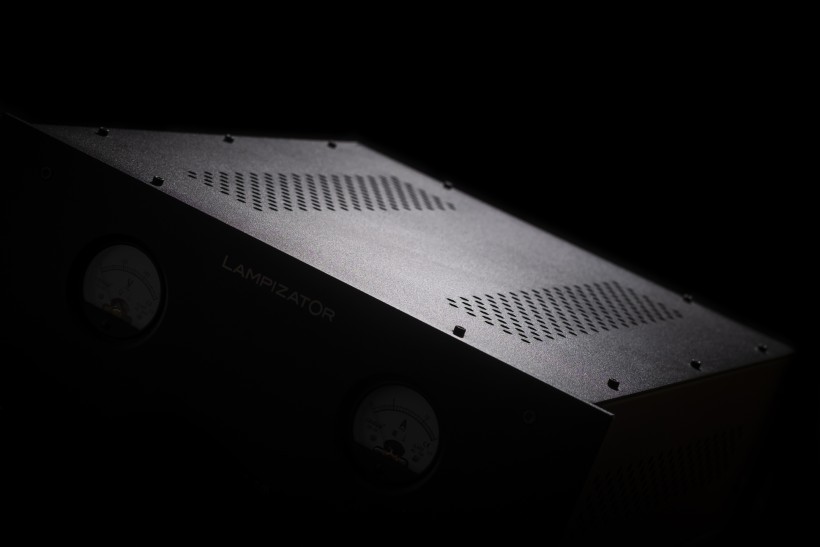 While the Kraftwerk-10 very quickly emerged as a nicely sorted performer, its showing off in the spatial department was an impressive trait to my ears, not a con. To simplify, if the LessLoss extracted the best out of my system while keeping its own personality at bay, the local power multiplier largely followed suit on all relevant fronts yet didn’t hold back with adding that extra spiciness on top. Come to think of it, all my previous LampizatOr DACs including the latest arrival had that communicative, direct and intense attitude to them. In a way, the Kraftwerk-10’s gearing was somewhat similar. Just so we’re clear, that doesn’t steal anything from what this machine does for sonics and how. This is a highly competent design that delivers what we’d expect from its kind. While I initially assumed that it’d steer my rig’s sound towards the additional fluffiness, warmth, density, copperish hues and relaxation paid at a steep cost as explained above, nothing of the sort had happened. In my book that’s a major win on its own right. Most importantly, in that system the Kraftwerk-10 behaved as advertised on sheer dynamics, speed and spatial scale, which was yet another very pleasant surprise. It proved as gifted as the LessLoss particularly on angry electronic fare packed with wicked bass jabs and passages in demand of high reflexes. Today’s subject secured tight control downstairs, proper momentum, crack, snap and reach without a hint of bloat, fuzz or laziness. I call this a job well done and also am clueless how Łukasz pulled this with parts widely considered as pace breakers in power distributors such as his. The outcome was what it was, so I couldn’t care less. Lastly, this was in order when my amps connected to the unfiltered outlets, while the DAC, streamer and preamp saw non-DC-block filtered sockets. The linear PSU was the only device that connected to the DC-blocked output. Monos fed from an outlet any other than the unfiltered type produced slower sound as predicted, and the digital end atop pre on DC-blocked sockets netted lesser articulation. The linear PSU didn’t mind, but the difference was in its trafo either quiet or not. This was my ideal use case scenario. Yours may be different. Kraftwerk-10 kindly allows for quite a few experiments and that is the important part. Let’s wrap.
While the Kraftwerk-10 very quickly emerged as a nicely sorted performer, its showing off in the spatial department was an impressive trait to my ears, not a con. To simplify, if the LessLoss extracted the best out of my system while keeping its own personality at bay, the local power multiplier largely followed suit on all relevant fronts yet didn’t hold back with adding that extra spiciness on top. Come to think of it, all my previous LampizatOr DACs including the latest arrival had that communicative, direct and intense attitude to them. In a way, the Kraftwerk-10’s gearing was somewhat similar. Just so we’re clear, that doesn’t steal anything from what this machine does for sonics and how. This is a highly competent design that delivers what we’d expect from its kind. While I initially assumed that it’d steer my rig’s sound towards the additional fluffiness, warmth, density, copperish hues and relaxation paid at a steep cost as explained above, nothing of the sort had happened. In my book that’s a major win on its own right. Most importantly, in that system the Kraftwerk-10 behaved as advertised on sheer dynamics, speed and spatial scale, which was yet another very pleasant surprise. It proved as gifted as the LessLoss particularly on angry electronic fare packed with wicked bass jabs and passages in demand of high reflexes. Today’s subject secured tight control downstairs, proper momentum, crack, snap and reach without a hint of bloat, fuzz or laziness. I call this a job well done and also am clueless how Łukasz pulled this with parts widely considered as pace breakers in power distributors such as his. The outcome was what it was, so I couldn’t care less. Lastly, this was in order when my amps connected to the unfiltered outlets, while the DAC, streamer and preamp saw non-DC-block filtered sockets. The linear PSU was the only device that connected to the DC-blocked output. Monos fed from an outlet any other than the unfiltered type produced slower sound as predicted, and the digital end atop pre on DC-blocked sockets netted lesser articulation. The linear PSU didn’t mind, but the difference was in its trafo either quiet or not. This was my ideal use case scenario. Yours may be different. Kraftwerk-10 kindly allows for quite a few experiments and that is the important part. Let’s wrap.
Newcomers to the power distributor breed may see LampizatOr Kraftwerk-10 as too expensive to bother, while veterans in pursuit of the ultimate performance already spend their money on minimalist one-job solutions such as my daily drivers. This report’s LampizatOr won’t change their minds. It doesn’t have to. Fans of the brand who enjoy the idea of protecting and powering 8+ devices at once without penalizing their sonic performance are the target audience. If that’s you, then trying out Kraftwerk-10 in your system and finding out what it does there sounds like a solid plan to me. Considering all the utilities this power box packs and how impressive it is where it matters, I don’t see a reason why you shouldn’t.
Associated Equipment:
- Amplifier: Trilogy 995R, FirstWatt F7, Enleum AMP-23R
- DAC: LampizatOr Horizon360 (Stradi 5U4G + Psvane Art TIII 4x KT88 / 2x 6SN7)
- Speakers: Boenicke Audio W11 SE+, sound|kaos Vox 3afw
- Transport: Innuos Statement, fidata HFAS1-S10U
- Preamplifier: Trilogy 915R, Thöress DFP
- Speaker cables: Boenicke Audio S3, LessLoss C-MARC
- Headphones: HifiMan Susvara
- Speaker signal conditioning: LessLoss Firewall for Loudspeakers, Boenicke ComDev
- Anti-vibration conditioning: 6x Carbide Base Diamond (under speakers), 6x Carbide Base Micro Diamond with TwinDamp inserts and spikes (under DAC and pre)
- Interconnects: LessLoss Entropic Process C-MARC, Boenicke Audio IC3 CG
- Power components: Gigawatt PC-3 SE EVO+/LC-3 EVO, LessLoss C-MARC, LessLoss Entropic Process C-MARC, Boenicke Audio Power Gate, ISOL-8 Prometheus
- USB components: AudioPhonique Desire USB
- Rack: Franc Audio Accesories Wood Block Rack 1+3
- Network: Fidelizer EtherStream, Linksys WRT160N
- Music: NativeDSD
Retail prices of reviewed components in EU (incl. VAT):
- LampizatOr Kraftwerk-10: €4’000
Manufacturer: LampizatOr


